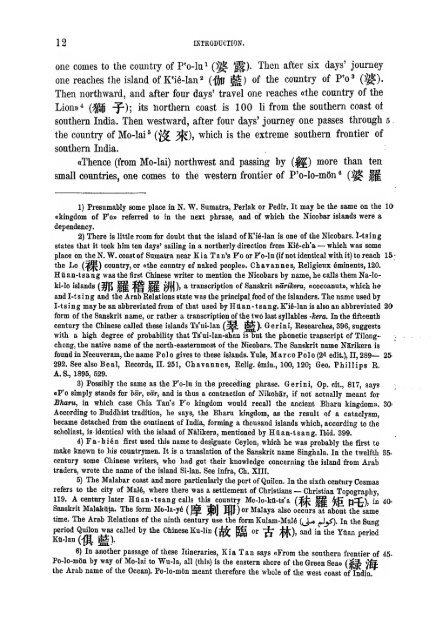Chau Ju-Kua - University of Oregon Libraries
Chau Ju-Kua - University of Oregon Libraries
Chau Ju-Kua - University of Oregon Libraries
You also want an ePaper? Increase the reach of your titles
YUMPU automatically turns print PDFs into web optimized ePapers that Google loves.
1<br />
2<br />
IXTRODUCTION.<br />
one comes to the country <strong>of</strong> P'o-lu^ (I^ ^). Then after six days' journey<br />
one reaches the island <strong>of</strong> K'i^-lan'' ("Ijja ^) <strong>of</strong> the country <strong>of</strong> P'o^ (^).<br />
Then northward, and after four days' travel one reaches «the country <strong>of</strong> the<br />
Lion»* (^1^ ^); its northern coast is 100 li from the southern coast <strong>of</strong><br />
southern India. Then westward, after four days' journey one passes through 5<br />
the country <strong>of</strong> Mo-lai* (^ ^),<br />
southern India.<br />
which is the extreme southern frontier <strong>of</strong><br />
more than ten<br />
small ci>untries, one comes to the western frontier <strong>of</strong> P'o-lo-mSn " (^ ^<br />
((Thence (from Mo-lai) northwest and passing by {^)<br />
1) Presumably some place in N. W. Sumatra, Perlak or Pedir. It may be the same on the 10<br />
((kingdom <strong>of</strong> P'o» referred to in the next phrase, and <strong>of</strong> which the Nicobar islands were a<br />
dependency.<br />
2) There is little room for doubt that the island <strong>of</strong> K'i6-Ian is one <strong>of</strong> the Nicobars. t-tsing<br />
states that it took him ten days' sailing in a northerly direction from Kie-ch'a — which was some<br />
place on the N. W. coast <strong>of</strong> Sumatra near Kia Tan's P'o or Fo-ln (if not identical with it) to reach 15-<br />
the Lo (f^) country, or «the country <strong>of</strong> naked peoplen. Chavannes, Religieux eminents, 120.<br />
Httan-tsang was the first Chinese writer to mention the Nicobars by name, he calls them Na-lo-<br />
ki-lo islands (fiK ^S ^S ^S l^'I'l): ^ transcription <strong>of</strong> Sanskrit nSrikera, (tcocoanutn, which he<br />
and I-tsing and the Arab Relations state was the principal food <strong>of</strong> the islanders. The name used by<br />
I-tsing may be an abbreviated from <strong>of</strong> that used by Htian-tsang. K'i6-lan is also an abbreviated 20"<br />
form <strong>of</strong> the Sanskrit name, or rather a transcription <strong>of</strong> the two last syllables -leera. In the fifteenth<br />
century the Chinese called these islands Ts'ui-lan (^S ^§)- Gerini, Besearches, 396, suggests-<br />
with a high degree <strong>of</strong> probability that Ts'ui-lan-shan is but the phonetic transcript <strong>of</strong> Tilong-<br />
chong, the native name <strong>of</strong> the north-easternmost <strong>of</strong> the Nicobars. The Sanskrit name Narikera is<br />
found in Necuveram, the name Polo gives to these islands. Yule, MarcoPolo(2d edit.), II, 289— 25-<br />
292. See also Beal, Records, II. 251, Chavannes, Relig. §min., 100, 120; Geo. Phillips R.<br />
A. S., 1895, 529.<br />
3) Possibly the same as the P'o-lu in the preceding phrase. Gerini, Op. cit., 817, says<br />
ttP'o simply stands for lar, var, and is thus a contraction <strong>of</strong> Nikobar, if not actually meant for<br />
Bharu, in which case Chia Tan's P'o kingdom would recall the ancient Bharu kingdom)). 30'<br />
According to Buddhist tradition, he says, the Bharu kingdom, as the result <strong>of</strong> a cataclysm,<br />
became detached from the continent <strong>of</strong> India, forming a thousand islands which, according to the<br />
scholiast, is identical with the island <strong>of</strong> Nalikera, mentioned by Htian-tsang. Ibid. 399.<br />
4) Fa-hien first used this name to designate Ceylon, which he was probably the first to<br />
make known to his countrymen. It is a translation <strong>of</strong> the Sanskrit name Singhala. In the twelfth 35.<br />
century some Chinese writers, who had got their knowledge concerning the island from Arab<br />
traders, wrote the name <strong>of</strong> the island Si-lan. See infra, Ch. Xllf.<br />
5) The Malabar coast and more particularly the port <strong>of</strong> Quilon. In the sixth century Cosmas<br />
refers to the city <strong>of</strong> Mal6, where there was a settlement <strong>of</strong> Christians — Christian Topography,<br />
119. A century later Httan-tsang calls this country Mo-lo-kO-ts'a (^jt ^ ^g ti-fr), in 40'<br />
Sanskrit Malakuta. The form Mo-la-ye (^ ^J ;^) or Malaya also occurs' at about the same<br />
time. The Arab Relations <strong>of</strong> the ninth century use the form Kulam-Mal6 (jl

















